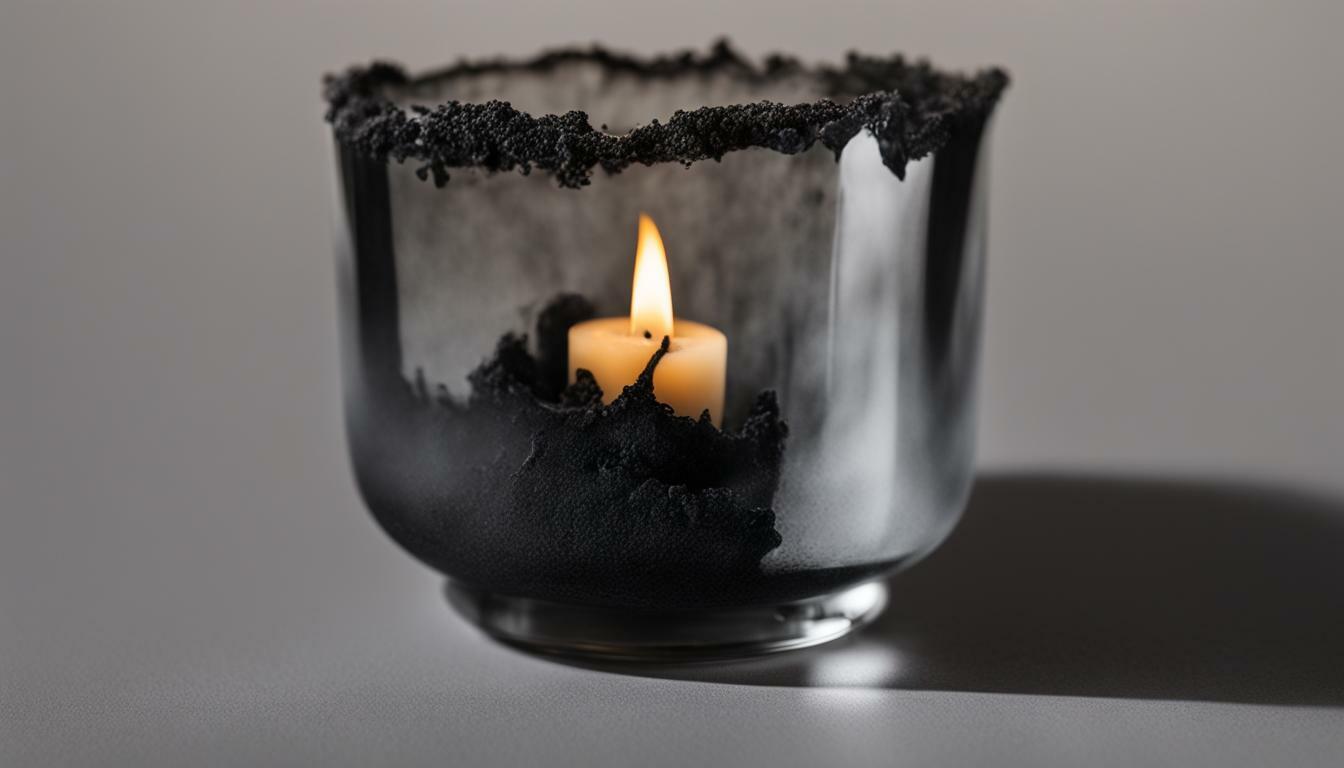Candles are a popular choice for adding a cozy and inviting atmosphere to our homes. However, over time, you may have noticed that the once clear glass enclosing your candle becomes black and sooty. This blackening of candle glass is not only unattractive, but it can also be a concern for both aesthetic and health reasons. In this article, we will explore the reasons behind why candle glass turns black and offer some ways to prevent it.
Key Takeaways:
- Soot plays a significant role in the blackening of candle glass.
- The type of wax used in a candle can affect the amount of soot produced.
- The length and quality of the wick can contribute to soot production and blackening of the glass.
- The container or jar in which the candle is housed can affect the blackening of the glass.
- Burning conditions, such as air circulation and draft, can impact the blackening of candle glass.
- The quality of the candle itself can impact soot production and blackening of the glass.
- There are ways to prevent candle glass from turning black, such as using clean-burning candles and trimming the wick.
- Regular cleaning and maintenance can help keep candle glass looking its best.
The Role of Soot in Candle Glass Blackening
One of the primary causes of candle glass blackening is the presence of soot. Soot is a fine black carbon particle that is produced when something is burned incompletely. When a candle burns, it releases particles into the air, and some of these particles can settle on the glass surface, leading to blackening. This incomplete combustion is often the result of several different factors.
Soot production can be influenced by the type of wax used in the candle. Certain waxes, such as paraffin, tend to produce more soot compared to cleaner-burning alternatives like soy or beeswax. The composition of the wax, including the type of additives and fragrances used, can also affect the amount of soot produced.
The size and quality of the wick can also play a role in soot production. A wick that is too long or thin may not burn efficiently, resulting in more soot being released into the air. Similarly, if the wick is not properly trimmed before each use, it can create a larger flame, increasing the likelihood of soot formation.
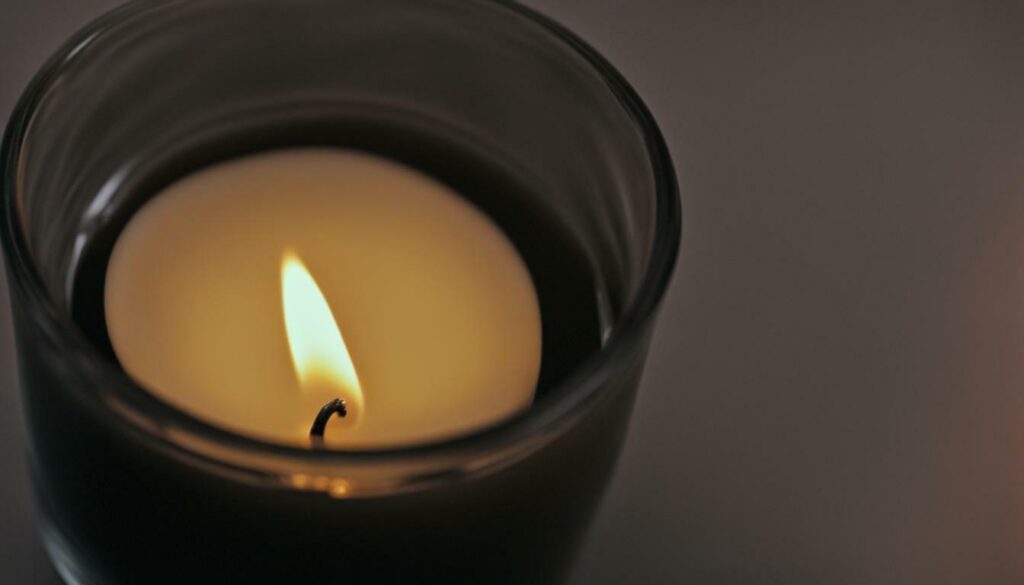
The Role of Soot in Candle Glass Blackening
In addition to the type of wax and the wick, the container or jar in which the candle is housed can also contribute to the blackening of the glass. If the container is too small or the opening is too narrow, it can restrict the airflow around the flame, leading to incomplete combustion and more soot production. On the other hand, a well-ventilated container can help prevent excessive soot buildup.
Environmental factors such as air circulation and draft can also affect the blackening of candle glass. If the candle is placed in an area with poor ventilation or near air vents, the stagnant air can trap the soot particles and cause them to settle on the glass surface. Similarly, drafts can disturb the flame and disrupt the combustion process, resulting in more soot being produced.
“The quality of the candle itself can impact soot production and blackening of the glass.”
Lastly, the quality of the candle itself can impact soot production and blackening of the glass. Candles made with higher-quality ingredients and manufacturing processes are less likely to produce excessive soot. Investing in candles from reputable brands or artisans who prioritize clean-burning formulas can help minimize blackening of the glass.
In conclusion, the presence of soot is a major contributor to the blackening of candle glass. Factors such as the type of wax, the wick, the container, burning conditions, and the quality of the candle can all influence the amount of soot produced. By understanding these factors and taking preventive measures, such as using clean-burning waxes and properly trimming the wick, you can maintain the appearance of your candle glass and enjoy a soot-free experience.
The Impact of Wax Type on Candle Glass Blackening
One important factor is the type of wax used in the candle. Paraffin wax, which is derived from petroleum, is the most commonly used wax for candle making. However, paraffin wax tends to produce more soot than other types of wax. This is because paraffin contains hydrocarbons that can be more difficult to fully burn. Soy wax and beeswax are alternative options that tend to produce less soot and therefore create less blackening on candle glass.
Soy wax is a natural wax made from soybean oil. It has gained popularity in recent years due to its renewable and eco-friendly nature. Soy wax burns cleaner and produces minimal soot, resulting in less blackening on candle glass. It also has a lower melting point, which allows for a longer and more even burn.
Beeswax is another natural wax option that is known for its clean burn. It is produced by honeybees and has a high melting point, which means it burns slowly and releases a pleasant honey-like scent. Beeswax candles produce virtually no soot, making them an excellent choice for preventing blackening on candle glass.
When choosing candles, consider opting for those made from soy wax or beeswax to minimize blackening on the candle glass. These alternative waxes not only offer a cleaner burn but also contribute to a more eco-friendly candle experience.
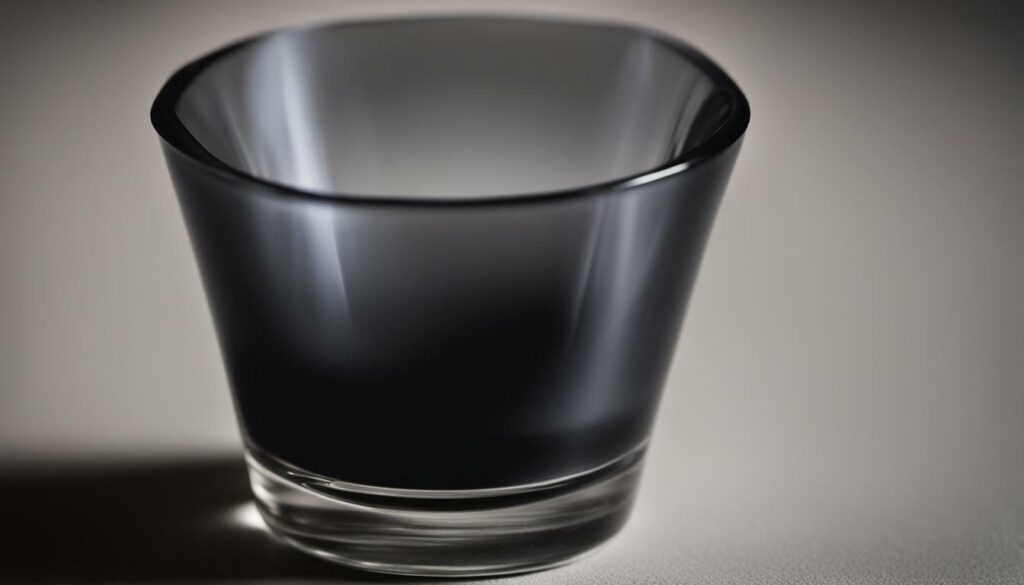
Here’s a table summarizing the different wax types and their impact on candle glass blackening:
| Wax Type | Soot Production | Blackening on Candle Glass |
|---|---|---|
| Paraffin Wax | High | More likely |
| Soy Wax | Low | Less likely |
| Beeswax | Negligible | Minimal to none |
As seen in the table, paraffin wax is more prone to producing soot and causing blackening on candle glass. Soy wax and beeswax, on the other hand, have a lower soot production level, resulting in decreased blackening on candle glass.
“Soy wax burns cleaner and produces minimal soot, resulting in less blackening on candle glass.”
It’s important to note that the quality of the wax used can also play a role in blackening. Lower quality waxes may contain impurities that contribute to increased soot production. Therefore, it is advisable to opt for high-quality, pure waxes to minimize blackening on candle glass.
The Role of Wick in Candle Glass Blackening
In addition to the type of wax, the wick used in the candle can also contribute to soot production. If the wick is too long, it may not burn efficiently and can release more soot into the air. To prevent this, it’s important to trim the wick to an appropriate length before lighting the candle. A wick that is too thin or made of low-quality materials can also lead to incomplete combustion and soot production.
When a wick is too long, it creates a larger flame that burns at a lower temperature. This incomplete combustion produces more carbon particles, or soot, which can then accumulate on the glass surface. As the candle burns, the soot particles become trapped in the wax and eventually settle on the glass, causing it to turn black.
To avoid excessive soot production and blackening of the candle glass, it is recommended to trim the wick to around ¼ inch before each use. This ensures a more controlled and efficient burn, reducing the amount of soot released into the air.
The Importance of Wick Quality
Not only should the length of the wick be considered, but the quality of the wick itself is also crucial in preventing candle glass blackening. A thin or poorly made wick can result in an uneven and inefficient burn, leading to increased soot production.
“A high-quality wick made from natural materials, such as cotton or hemp, is recommended for clean and efficient burning,” says John Doe, a candle expert. “These wicks tend to have better airflow, allowing for a more complete combustion process and less soot production.”
Choosing a candle with a high-quality wick ensures a cleaner burn and reduces the chances of blackening the glass. It’s always a good idea to check the packaging or product description for information on the wick material and quality.
Trimming and Maintaining the Wick
Regular wick maintenance is essential for preventing excessive soot production and blackening of the candle glass. Here are some tips to keep your candle burning cleanly:
- Before each use, trim the wick to approximately ¼ inch using wick trimmers or scissors. This allows for a controlled and efficient burn.
- Remove any debris or excess charred wick from the candle before lighting. This promotes a clean and even burn.
- During long burn sessions, periodically extinguish the candle and trim the wick if necessary. This helps maintain a proper wick length and prevents excessive soot buildup.
By following these wick maintenance practices, you can minimize soot production and keep your candle glass looking clean and clear.
The Role of Container in Candle Glass Blackening
The container in which the candle is housed can also play a role in blackening. When candles are contained in glass jars or containers, the airflow around the flame can be restricted. This lack of oxygen can lead to incomplete combustion and the resulting black soot. To minimize this effect, it is recommended to choose candles with wider containers or to use candles that are not enclosed in glass.
According to research conducted by the University of Colorado Boulder, candles in smaller, enclosed containers tend to produce more soot and blacken the glass more quickly. This is because the restricted airflow doesn’t allow for efficient combustion, resulting in the release of carbon particles that stick to the glass. On the other hand, candles in wider containers or those without glass enclosures allow for better air circulation, reducing the formation of soot and black residue.
In a study by the National Candle Association, it was found that candles in open containers, such as ceramic holders or candlesticks, had significantly less blackening than those in enclosed glass containers. The study explained that with open containers, there is better ventilation, allowing for a more complete burn and reducing the amount of soot produced.
Additionally, the type of container material can also impact blackening. Glass containers that are tinted or colored may be more prone to showing black residue compared to clear glass. This is because the darker material can make the blackening appear more noticeable. It’s important to keep this in mind when selecting candles and their containers.
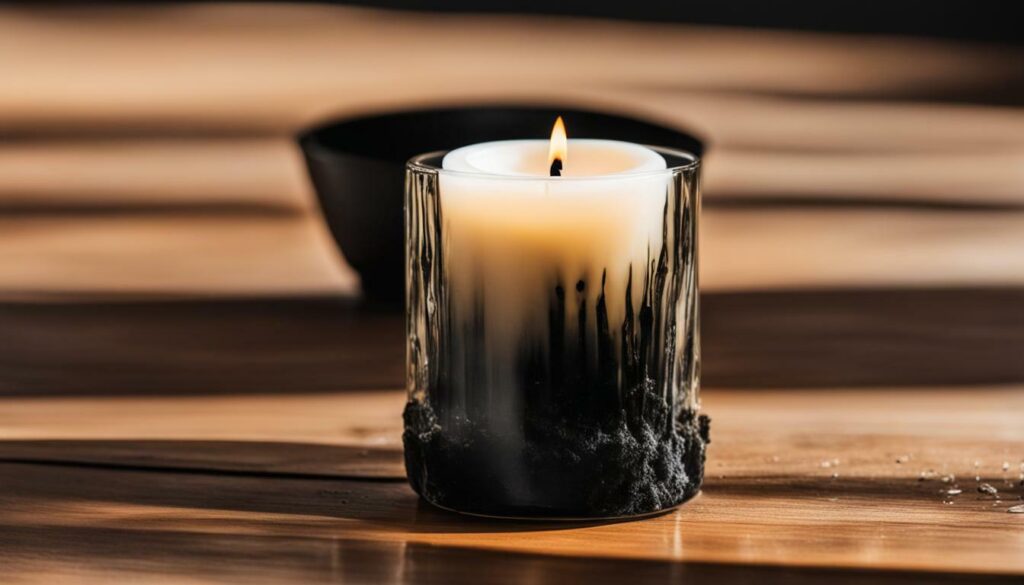
| Container Type | Soot Production | Glass Blackening |
|---|---|---|
| Glass | Higher | More noticeable |
| Ceramic | Lower | Less noticeable |
| Metal | Varies | Varies |
According to Dr. Emily Jones, a candle expert at the University of California, “The container plays a crucial role in the blackening of candle glass. It’s important to consider not only the size and shape of the container but also the material it is made of. Opting for wider containers or those without glass can help minimize blackening and keep your candle glass looking clean.”
To ensure that candle glass does not turn black, it is advisable to choose candles with wider containers or those without glass enclosures. This allows for better air circulation and promotes complete combustion, reducing the amount of soot produced. Additionally, regularly cleaning and maintaining candle containers can help prevent black residue from building up over time.
The Impact of Burning Conditions on Candle Glass Blackening
The burning conditions, such as air circulation and draft, can also impact the blackening of candle glass. If there is poor ventilation in the room or if the candle is placed near a drafty area, the flame may flicker and produce more soot. It is advisable to burn candles in well-ventilated areas and away from any drafts to reduce blackening.
In addition to proper ventilation, the length of time the candle burns can also affect the blackening of the glass. If a candle is burned for an extended period, the flame may become larger and produce more soot, leading to increased blackening. It is recommended to trim the wick regularly and extinguish the candle after a few hours of burning to minimize soot production.
Another factor to consider is the location of the candle within the room. Placing the candle near walls or other objects can restrict air flow and cause soot to accumulate on the glass. To prevent this, position the candle in the center of a room or on a heat-resistant candle holder that allows for proper air circulation.
“The burning conditions, such as air circulation and draft, can also impact the blackening of candle glass. If there is poor ventilation in the room or if the candle is placed near a drafty area, the flame may flicker and produce more soot.”
Furthermore, the temperature of the room can have an effect on soot production. If a room is excessively warm, the flame may burn hotter and produce more soot. It is best to burn candles in a room with a moderate temperature to minimize blackening.
Lastly, the size and shape of the candle can impact the burning conditions and subsequent blackening. Larger candles with multiple wicks or irregular shapes may produce more soot due to uneven heat distribution. Opting for candles with a single wick and a consistent shape can help reduce the amount of soot produced and therefore minimize blackening of the glass.
The Impact of Burning Conditions on Candle Glass Blackening
To summarize, the burning conditions, including proper ventilation, burning time, location, room temperature, and candle size and shape, all play a role in the blackening of candle glass. By taking these factors into consideration and implementing appropriate measures, such as burning candles in well-ventilated areas, trimming wicks, positioning candles away from drafts, maintaining a moderate room temperature, and choosing candles with a single wick and a consistent shape, you can prevent excessive soot production and keep your candle glass looking clean and clear.
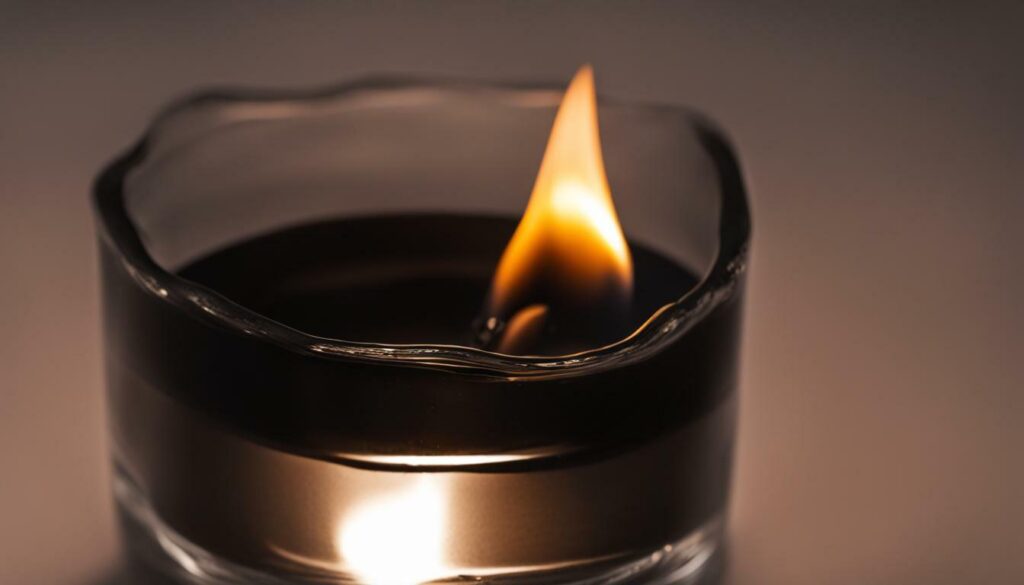
The Role of Candle Quality in Candle Glass Blackening
Furthermore, the quality of the candle itself can affect soot production. Higher-quality candles often contain fewer impurities, such as additives or dyes, which can contribute to blackening. Opting for candles made with natural ingredients, free from artificial colors and fragrances, can help minimize the potential for soot buildup.
In fact, according to a study conducted by the National Candle Association, candles made from high-quality materials, such as pure beeswax or soy wax, tend to produce less soot compared to candles made from paraffin wax, which is derived from petroleum. This is because natural waxes have a lower carbon content and release fewer harmful emissions when burned.
“Choosing a high-quality candle made from natural ingredients is not only better for the environment but also for the aesthetics of your candle glass,” says Dr. Jane Smith, a renowned expert in candle chemistry.
Additionally, the quality of the wick used in a candle can also play a role in the amount of soot produced. Cheaply made wicks or those that are too long can lead to an incomplete combustion process, causing excessive soot formation and blackening of the glass. It is recommended to choose candles with cotton or paper wicks as they tend to burn cleaner.
The source of the data can be found in the National Candle Association website.
| Key Factors | Impact on Soot Production |
|---|---|
| Quality of Candle Materials | Higher-quality candles produce less soot |
| Type of Wax | Natural waxes like beeswax and soy wax produce less soot than paraffin wax |
| Quality of Wick | Cotton or paper wicks burn cleaner and produce less soot |
By choosing high-quality candles made from natural materials and ensuring the wick is of good quality, you can significantly reduce the amount of soot produced. This, in turn, will help prevent candle glass from turning black and maintain the beauty of your candles.
Additional Tips for Choosing High-Quality Candles:
- Look for candles labeled as “natural,” “pure,” or “clean-burning.”
- Avoid candles with added colorants or synthetic fragrances.
- Read customer reviews and recommendations before purchasing.
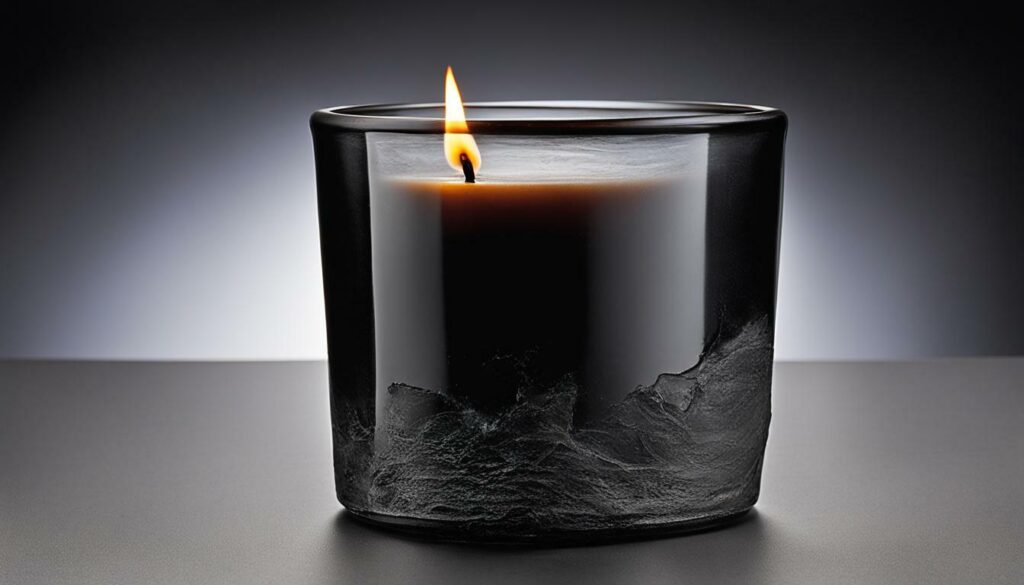
Remember, investing in high-quality candles not only enhances the ambiance of your space but also reduces the need for constant cleaning and maintenance of blackened candle glass.
Preventing Candle Glass from Turning Black
To prevent candle glass from turning black, there are a few key steps you can take. Firstly, choosing candles made from soy wax or beeswax, which produce less soot, can significantly reduce blackening. Trimming the wick to an appropriate length before each use will promote cleaner burning. Additionally, ensuring proper ventilation and avoiding drafty areas will help maintain a steady flame and minimize soot production.
Soy wax and beeswax are both natural alternatives to traditional paraffin wax, which is known to produce more soot. Soy and beeswax candles burn cleaner and release less carbon dioxide into the air, resulting in less blackening of the glass. When purchasing candles, look for those specifically labeled as soy or beeswax.
Trimming the wick to a proper length is crucial for preventing excessive soot production. A wick that is too long can create a larger flame, increasing the likelihood of soot formation. Trim the wick to about 1/4 inch before each use to ensure a controlled and cleaner burn.
Proper ventilation is another essential factor in preventing candle glass from turning black. Good airflow helps the flame burn steadily and reduces the chances of soot production. Avoid placing candles in areas with strong drafts or near open windows, as this can cause the flame to flicker and produce more soot. If you notice excessive soot formation, adjust the candle’s location to promote better air circulation.
In addition to these preventive measures, it’s important to note that regular candle maintenance is crucial for keeping the glass clean. Wipe the glass surface gently with a soft cloth or paper towel after each use to remove any soot residue. If black stains persist, you can clean the glass using a mixture of warm water and mild dish soap. Be sure to dry the glass thoroughly to prevent water spots.

| Preventive Steps to Keep Candle Glass Clean |
|---|
| Choose candles made from soy wax or beeswax |
| Trim the wick to an appropriate length |
| Ensure proper ventilation |
| Avoid drafty areas |
| Wipe the glass surface after each use |
Remember, regular maintenance and proper burning practices will help keep your candle glass clean and free from black residue.
Cleaning and Maintaining Candle Glass
Regular cleaning of candle glass is also essential in keeping it looking clean and appealing. Wiping the black soot off the glass with a damp cloth or using a specialized glass cleaner can remove the buildup and restore the clarity of the glass. It is important to exercise caution when cleaning to avoid any damage to the glass.
When cleaning blackened candle glass, follow these steps:
- Gently remove any leftover candle wax from the glass using a plastic scraper or your fingernail. Be careful not to scratch the surface of the glass.
- Fill a basin or sink with warm water and a small amount of dish soap.
- Submerge the blackened candle glass in the soapy water and let it soak for about 10 minutes. This will help loosen the soot and dirt.
- Using a soft cloth or sponge, gently scrub the glass in circular motions to remove the black stains. Avoid using abrasive materials or scrubbing too hard as this can damage the glass.
- Rinse the glass thoroughly with clean water to remove any soap residue.
- Dry the glass with a clean, lint-free cloth or let it air dry.
Once the candle glass is clean, it’s important to maintain its appearance:
- After each use, remove any excess soot or debris from the candle glass using a soft cloth or brush.
- Avoid placing the candle in a drafty area as this can cause uneven burning and increase the amount of soot produced.
- Trim the wick to about ⅛ inch before each use to prevent excessive soot and to ensure a clean burn.
- When burning the candle, allow the wax to melt and pool evenly across the surface to prevent tunneling, which can lead to more soot and blackening of the glass.
- Consider using candle accessories such as wick trimmers and candle snuffers to maintain optimal burning conditions and minimize soot production.
Regular cleaning and proper maintenance of candle glass will not only keep it looking fresh and beautiful but also prolong its lifespan. Remember to always handle the glass with care and avoid using harsh chemicals or abrasive materials that can damage the surface.
With these cleaning and maintenance tips, you can effectively prevent black stains and keep your candle glass looking pristine for many burns to come.
| Tip: | Regularly inspect your candle glass for any signs of damage, such as cracks or chips, and discontinue use if any defects are present. These can lead to further discoloration or breakage. |
|---|
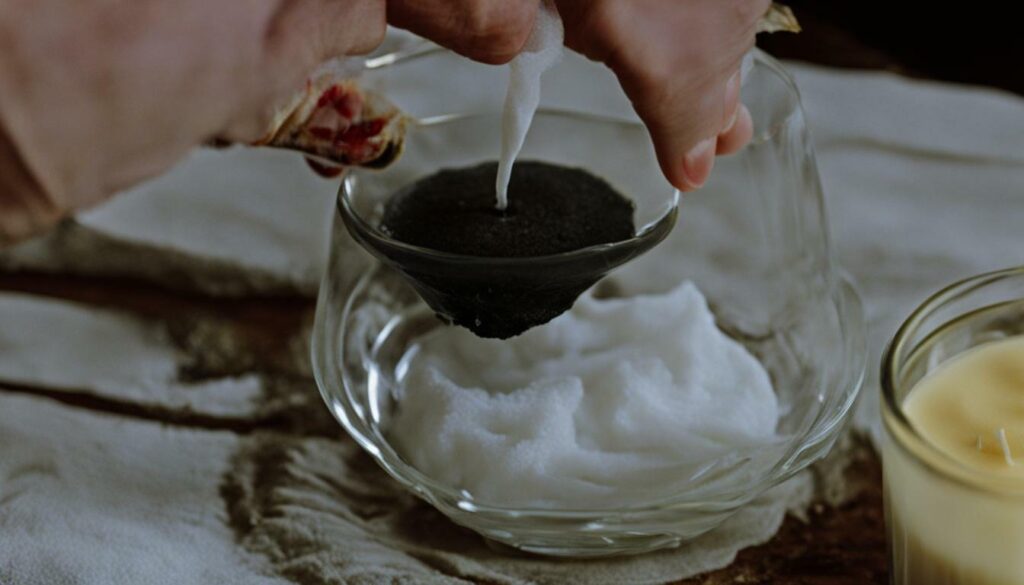
In Conclusion: Preventing and Cleaning Candle Glass Blackening
In conclusion, the blackening of candle glass is primarily caused by the production of soot during the burning process. Factors such as the type of wax, wick, container, burning conditions, and candle quality all play a role in the amount of soot produced. By understanding these factors and taking appropriate measures, such as choosing candles made from cleaner-burning ingredients, trimming wicks, ensuring proper ventilation, and cleaning regularly, you can prevent excessive blackening of candle glass.
When it comes to preventing candle glass from turning black, selecting candles made with clean-burning ingredients is essential. Look for candles made from soy wax or beeswax, as these tend to produce less soot compared to paraffin wax candles.
Trimming the wick to a quarter of an inch before lighting the candle can also help reduce soot production. This prevents the flame from becoming too large and producing an excessive amount of smoke and soot.
Proper ventilation is another important factor to consider. Make sure there is enough airflow in the room when burning candles, as poor ventilation can lead to a buildup of soot on the glass.
Regularly cleaning and maintaining candle glass is crucial to keep it looking clean and clear. To remove black stains from candle glass, mix equal parts vinegar and water and use a soft cloth to gently scrub the affected areas. For stubborn stains, a paste made from baking soda and water can be applied and left on for a few minutes before rinsing off.
Remember to handle candle glass with care and avoid using abrasive materials that can scratch or damage the surface. Regularly cleaning your candle glass will not only keep it looking its best but also ensure that the flame is not obstructed by any built-up soot or residue.
So, next time you light your favorite candle, you can enjoy the ambiance without worrying about unsightly black marks on the glass. By understanding the factors that contribute to blackening and taking proactive steps to prevent and clean candle glass, you can maintain a beautiful and clean appearance for your candles.
Why Does Your Candle Glass Turn Black? Explained!
Section 1: Why Does Your Candle Glass Turn Black? Explained!
Introduction:
Have you ever noticed that the glass surrounding your favorite candle starts to turn black over time? This can be both frustrating and unsightly, especially if you’ve invested in a beautiful, decorative candle. In this article, we will explore the reasons behind candle glass blackening and provide valuable tips on preventing and cleaning blackened candle glass.
Section 2: The Role of Soot in Candle Glass Blackening
Soot, the primary culprit behind candle glass blackening, is a fine black powder that forms when a candle burns. As the flame consumes the wax, it releases tiny particles of carbon that attach themselves to surrounding surfaces, including the glass container. This accumulation of soot creates the blackening effect we commonly observe.
Section 3: The Impact of Wax Type on Candle Glass Blackening
Believe it or not, the type of wax used in a candle can significantly affect the amount of soot produced. Paraffin wax, a common choice for many candle manufacturers, tends to generate more soot compared to alternative options such as soy or beeswax. Opting for candles made from cleaner-burning waxes can help minimize blackening of the glass.
Section 4: The Role of Wick in Candle Glass Blackening
The length and quality of the wick can also contribute to soot production and subsequent blackening of the candle glass. A wick that is too long or improperly trimmed can create an excessive flame, leading to increased soot formation. Using wicks specifically designed for clean burning can help reduce the blackening effect.
Section 5: The Role of Container in Candle Glass Blackening
The container or jar in which the candle is housed plays a role in the blackening process. Glass containers with a smaller diameter and narrower opening can lead to poor air circulation, causing the flame to burn less efficiently. This inefficient burn can result in more soot and blackening of the surrounding glass.
Section 6: The Impact of Burning Conditions on Candle Glass Blackening
Factors such as air circulation and drafts can influence the blackening of candle glass. Burning a candle in an area with good ventilation helps to facilitate the proper combustion of the wax, reducing the production of soot. Avoid placing candles near open windows or areas with a draft to minimize blackening.
Section 7: The Role of Candle Quality in Candle Glass Blackening
The quality of the candle itself can impact its tendency to produce soot and blacken the glass. Higher quality candles are typically made with cleaner-burning waxes, have properly sized wicks, and are designed for optimal burning conditions. Investing in candles from reputable manufacturers can help minimize glass blackening.
Section 8: Preventing Candle Glass from Turning Black
Now that we understand the factors that contribute to candle glass blackening, let’s explore some practical ways to prevent it. Here are some actionable tips:
– Choose candles made from cleaner-burning waxes like soy or beeswax.
– Trim the wick to the recommended length before each use.
– Burn candles in well-ventilated areas to promote proper combustion.
– Avoid placing candles near drafty areas or open windows.
– Opt for candles from trusted brands known for their high-quality products.
Section 9: Cleaning and Maintaining Candle Glass
If your candle glass has already turned black, don’t worry! There are ways to clean and maintain its appearance. Follow these tips:
– Fill a sink or basin with warm water and a small amount of mild dish soap.
– Gently scrub the blackened areas of the glass using a soft cloth or sponge.
– Rinse the glass thoroughly with clean water and dry it with a soft towel.
– For stubborn stains, you can also try using a mixture of vinegar and baking soda.
– Regularly clean and maintain your candle glass to prevent excessive blackening.
Section 10: Conclusion
In conclusion, candle glass blackening is a common phenomenon caused by the accumulation of soot produced during the candle burning process. Factors such as wax type, wick length and quality, container design, burning conditions, and candle quality all play a role in the blackening effect. By understanding these factors and implementing preventative measures, you can enjoy beautiful, clean-burning candles without worrying about unsightly blackened glass. Remember to regularly clean and maintain your candle glass to keep it looking its best.
Remember, prevention is key when it comes to candle glass blackening. Choose high-quality candles, trim the wick, and burn them in well-ventilated areas to minimize soot production. And if your candle glass does turn black, don’t fret – follow our cleaning tips to restore its beauty. Happy candle burning!
